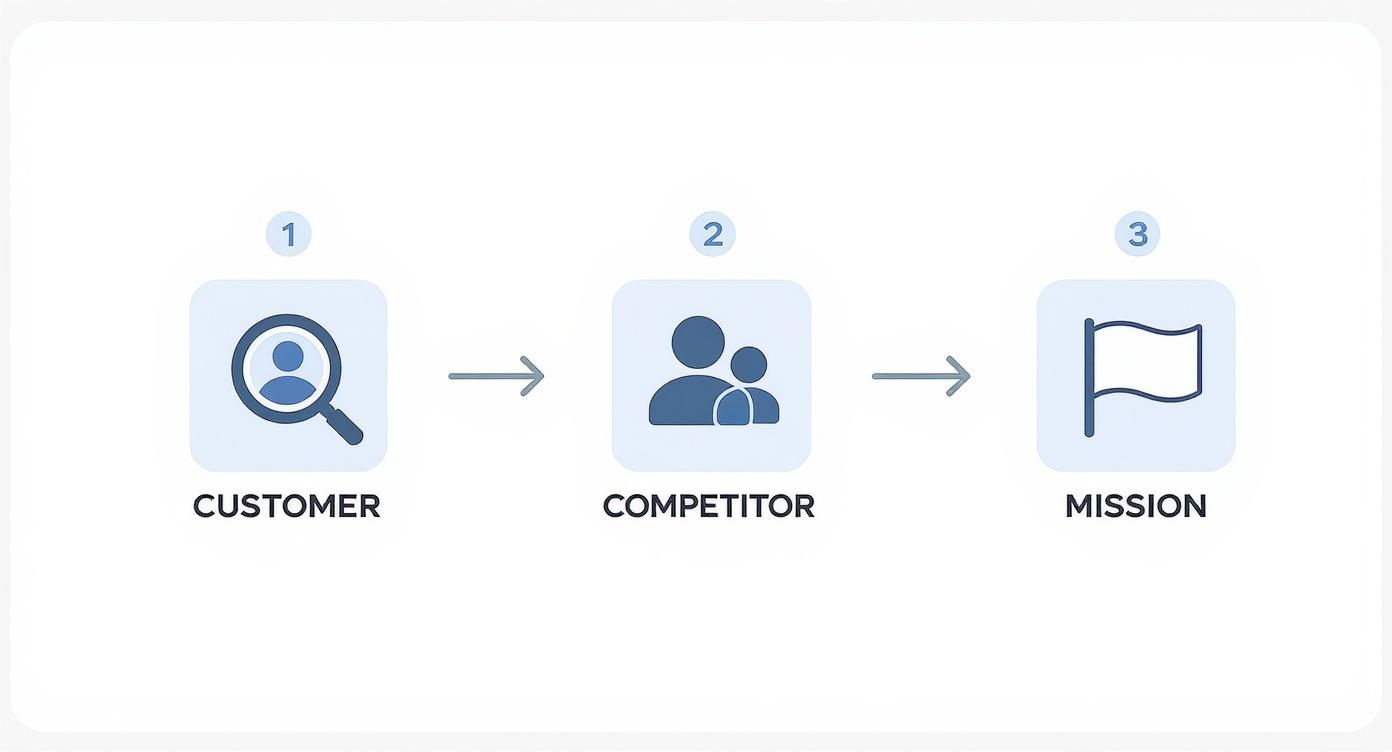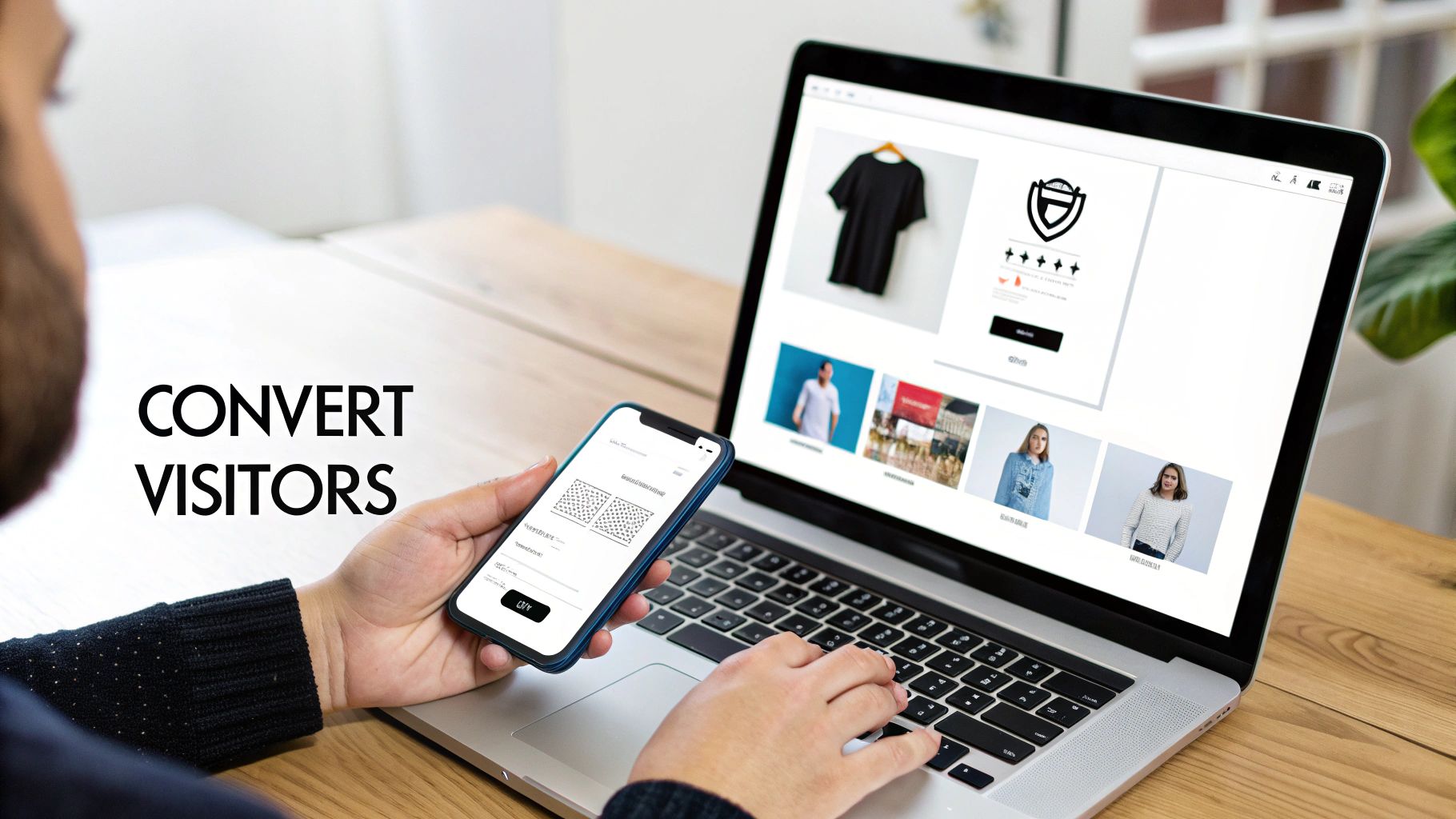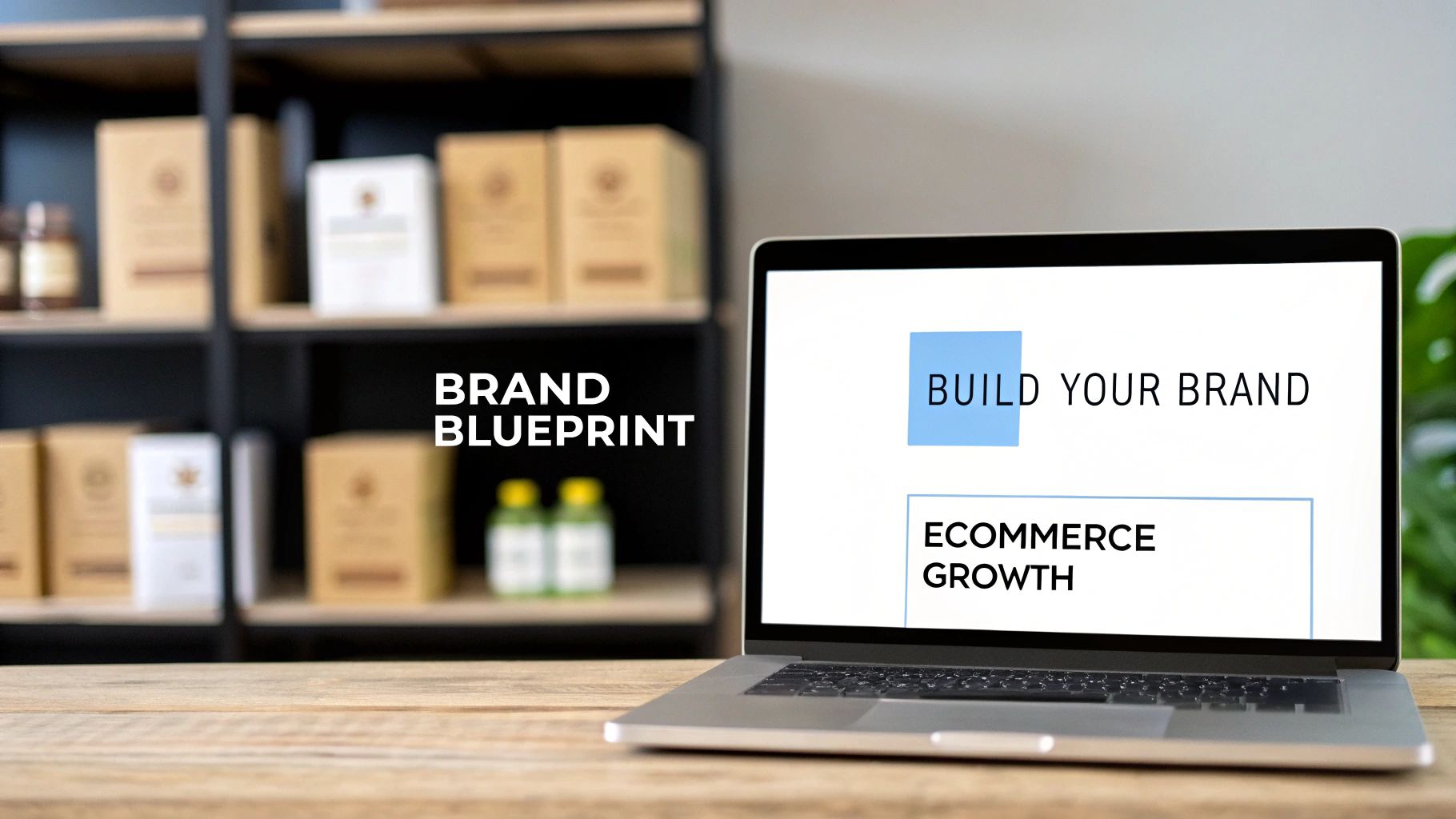A great brand isn't born from a cool logo or a catchy name. It’s built on a rock-solid foundation of research. This is where you roll up your sleeves and really get to know your customer, your competition, and most importantly, your own purpose. This early-stage work is what separates the brands that stick around from the ones that fade away.
Build Your Brand Foundation on Smart Research
Before you even think about fonts and color palettes, the real work begins. This is the strategic, investigative phase—the part that ensures your brand has substance. Too many founders get excited and jump straight to the fun, visual stuff. But skipping this step is like building a house without a blueprint; it might look okay for a little while, but it won't stand the test of time.
Real, lasting success comes from a deep understanding of three things: who you're selling to, who you're up against, and what makes you different. Nailing these elements gives you a clear roadmap for everything else, from your website copy to your social media ads.
Define Your Ideal Customer Persona
First things first: it’s not about you, it’s about them. You need a crystal-clear picture of who you're trying to reach. And I don't mean a vague demographic like "women, ages 25-40." That’s not nearly enough. We need to get specific and build a detailed customer persona.
Let’s say you sell sustainable yoga mats. You’re not just targeting "people who do yoga." Your ideal customer might be "Eco-Conscious Elena," a 32-year-old marketing manager living in a city. She values wellness, cares deeply about ethical sourcing, and will happily pay a premium for products that align with her values. You'd know she follows certain wellness influencers, shops at Whole Foods, and feels a little guilty about her carbon footprint. This level of detail is gold—it tells you exactly how to talk to her.
This visual shows how the whole research process flows, starting with your customer and ending with a mission that ties everything together.

Following this path ensures your brand is built for your customer, stands out from the crowd, and has a clear purpose from day one.
Analyze Your Competitors to Find Your Niche
Once you know your customer inside and out, it's time to see who else is trying to win them over. The point here isn't to copy your competitors. It's to find the gaps they've left open—the unmet needs or overlooked audiences. A good competitive analysis digs into a few key areas:
- Their Angle: How are they positioning themselves? Are they the cheapest option, the most luxurious, or the quirky newcomer?
- Their Look & Feel: What's their visual vibe? Is there a common aesthetic in your niche that you can either lean into or break away from?
- Customer Reviews: What do people love about them? Even better, what are the common complaints? Those complaints are your opportunities.
- Where They Hang Out: Are they all over TikTok but completely absent from Pinterest? Find out where they’re reaching customers.
A deep dive here will show you where you can shine. Maybe every other brand in your space has a muted, minimalist look. That’s your cue to come in with a bold, vibrant identity that speaks to a completely different customer mindset. For a more detailed walkthrough, check out our guide on how to conduct market research that drives growth.
A brand is no longer what we tell the consumer it is—it is what consumers tell each other it is. Your research helps you understand and shape that conversation from the very beginning.
Craft Your Mission and Value Proposition
Okay, you know your customer and you know the competition. Now, you can finally put a stake in the ground and define what your brand is all about. This comes down to two powerhouse statements: your mission and your value proposition.
Your mission statement is your "why." It's the reason you exist beyond just making a profit. Think of Patagonia: "We're in business to save our home planet." That mission drives every single thing they do.
Your unique value proposition (UVP) is your "what" and "how." It’s a punchy statement that explains the benefit you offer, how you solve a problem, and what makes you the best choice. It needs to be simple and instantly understandable. When the mattress brand Casper launched, its UVP was brilliant: "The perfect mattress, for everyone." It cut through the noise of a confusing market and offered a simple, quality solution.
This foundational work all comes down to building trust. And that trust is non-negotiable—a staggering 81% of consumers say they need to trust a brand before they will even consider making a purchase. It just goes to show how vital it is to get this right from the very start.
To keep you on track, here’s a quick checklist covering the essentials of this foundational phase.
Brand Foundation Checklist
This table breaks down the core elements you need to define before you move on to the more creative parts of branding. Think of it as your blueprint.
Once you’ve worked through these steps, you'll have a clear, strategic direction that will make every subsequent decision—from design to marketing—infinitely easier and more effective.
Crafting a Memorable Visual Identity and Voice
Alright, you've figured out who you are and who you're talking to. Now for the fun part: giving your brand a face and a voice. This is where all those abstract ideas about your mission and values start to feel real. It's about creating a look and a sound that people can actually see, hear, and connect with.
This isn't just about picking a nice logo and calling it a day. Your visual identity and brand voice are your most powerful communication tools. They work hand-in-hand to show off your personality, build that all-important trust, and forge an emotional connection that turns casual visitors into lifelong fans. Get this right, and every single touchpoint—from your homepage to a boring shipping email—will feel undeniably you.
Defining Your Visual Language
Your visual identity is way more than a logo. Think of it as the entire aesthetic of your brand—the colors, the fonts, the style of your photos. Every single element needs to be chosen with purpose, reflecting your brand’s personality and resonating with your ideal customer.
Color is a heavy hitter here. Colors stir up emotions and can instantly change how someone perceives your brand. Blue, for instance, often feels trustworthy and professional, which is why you see it everywhere in tech and finance. Green makes you think of nature, health, and calm, making it a no-brainer for wellness or eco-friendly brands.
The fonts you choose speak volumes, too. A classic serif font can give off a vibe of tradition and quality, while a clean sans-serif font often feels more modern and approachable. The goal is to pick a primary and secondary font that are easy to read but also match the feeling you’re trying to create.
Here's something to remember: visuals are processed 60,000 times faster in the brain than text. Your color palette and fonts make an impression in a split second, long before a customer reads a single word on your site.
A great starting point is to play around with a color palette generator. Tools like Canva’s are fantastic for this. You can upload a photo that just feels like your brand, and it will pull out a complementary color scheme for you.

This is a simple way to build a cohesive look from the very beginning, ensuring everything feels connected and intentional.
Finding Your Brand Voice
Just as important as how your brand looks is how it sounds. Your brand voice is the personality that shines through in every word you write. Are you witty and a bit sarcastic like Wendy's on Twitter? Or are you inspiring and motivational like Nike? Nailing this down is absolutely critical for consistency.
Your brand voice should come directly from your ideal customer persona. If you’re selling to "Eco-Conscious Elena," you might adopt a tone that’s educational, passionate, and optimistic. But if you’re trying to reach a younger, trend-obsessed crowd, your voice might be more casual, full of slang and emojis.
To really define your voice, think about these three things:
- Tone: What's the general attitude? Is it formal, funny, serious, or casual?
- Language: What kinds of words do you use? Are they simple and direct, or more technical and sophisticated?
- Rhythm: How does your writing flow? Do you use short, punchy sentences or longer, more descriptive ones?
Think about Dollar Shave Club. Their voice is cheeky, direct, and hilarious. It was a perfect match for their original audience of young guys who were sick of the hyper-masculine, over-the-top marketing from brands like Gillette. That distinct voice helped them completely disrupt an established market.
Once you’ve got a handle on these elements, you need to write them down. Documenting everything is key to keeping your team on the same page. To help with that, check out our guide on how to create brand guidelines. It'll walk you through creating a resource that keeps everyone consistent.
Ultimately, building a memorable brand is all about making deliberate choices. Every color, font, and word needs to work together to tell a clear and compelling story about who you are. This consistency is what builds a strong, recognizable, and trustworthy brand that people will remember.
Designing a Website That Converts Visitors
Think of your website as your digital flagship store. It’s your best salesperson, working 24/7, and it's where your brand’s promise truly gets tested. All that foundational work—the research, the visual identity, the brand voice—it all comes together here. A beautiful site is nice, but a beautiful site that sells is the real win.
The difference between a thriving ecommerce store and a forgotten one often comes down to translating your brand into an intuitive, seamless experience for your customer. This means getting obsessed with how people actually use your site, especially on their phones.

Embrace a Mobile-First Design Philosophy
Designing for the smallest screen first isn’t just a trend anymore; it's a flat-out necessity. The shift to mobile commerce is massive and undeniable. Projections show mobile commerce sales hitting $4.01 trillion by 2025, which will account for 59% of all ecommerce sales on the planet.
With a staggering 70% of shoppers reaching for their smartphones first, a site that isn't mobile-friendly is basically a leaky bucket, pouring potential revenue down the drain.
Adopting a mobile-first approach forces you to be ruthless with your priorities. You have to distill your navigation, product info, and calls-to-action down to their absolute essentials. This creates a clarity that, frankly, benefits users on every device, leading to a cleaner, more focused experience for everyone.
- Start Small: Build the mobile version of your site first, then scale it up for tablets and desktops.
- One Action Per Screen: On mobile, keep it simple. Each screen should have one primary goal, like a clear "Add to Cart" or "Learn More" button.
- Thumb-Friendly Design: Place key buttons and links where they are easy to tap with a thumb. Think about how people actually hold their phones.
This way of thinking ensures the vast majority of your visitors get a flawless experience, which is the cornerstone of building trust and, ultimately, making sales.
Structure an Intuitive User Journey
Ever walked into a physical store and felt completely lost? No clear aisles, hidden price tags, and the checkout counter is nowhere in sight. You'd probably turn around and leave. Your website is no different. A good user journey guides visitors from the moment they land on your site right through to purchase, without them ever having to think too hard about it.
Keep your navigation simple and predictable. Use common-sense labels like "Shop," "About," and "Contact." Now is not the time for clever, branded terms that might confuse a first-time visitor. A well-organized site not only feels better to use, but it also helps search engines understand and rank your pages. If you're looking for more on this, check out these https://www.softriver.co/blog/10-website-design-best-practices-for-2025.
Good design is invisible. It guides the user so seamlessly that they don't even notice the structure holding it all together. They just know it works.
To make sure your site is actually turning visitors into paying customers, it's essential to understand how to improve ecommerce conversion rates. This involves looking at—and optimizing—every single step of their path.
Craft Compelling Product Pages
Your product page is the final pitch. It's the moment where a shopper's interest turns into a decision to buy. This is no place for lazy descriptions or grainy photos. Every single element here needs to work together to build confidence and create a little bit of urgency.
High-Quality Visuals are Non-Negotiable
Since people can't physically touch or hold your product, your visuals have to do all the heavy lifting. Invest in professional photography and video. Show your product from every angle, show it in use, and get close-ups of the important details. Photos of happy customers using your product? Even better.
Write Descriptions That Sell Benefits, Not Just Features
Don't just list what your product has; explain what it does for the customer. A feature might be "contains hyaluronic acid." The benefit is "get a hydrated, youthful glow." Frame your copy around how your product makes your customer's life better. A mix of scannable bullet points for the quick facts and a short paragraph for storytelling is a great combo.
Make Your Calls-to-Action (CTAs) Obvious
Your "Add to Cart" button should be impossible to miss. Use a color that pops against the rest of the page and write clear, action-oriented text. Get rid of any clutter or distractions that might pull someone's attention away from this critical final step. A frictionless experience right at this moment is what separates a good website from a great one.
Launching and Marketing Your New Brand

The moment you "go live" should never be the beginning of your marketing. I've seen too many founders flip the switch and just hope people show up. A great launch is all about building a wave of momentum beforehand, creating anticipation that you can then channel into a real, sustainable growth engine.
This is the phase where all your hard work—the brand foundation, the visuals, the website—finally gets its first taste of the real world. You're taking the story you’ve crafted and actively putting it in front of the right people, on the right channels.
Build Buzz Before You Launch
The weeks leading up to your official opening are a golden opportunity. You can start building a community and an email list before you even have a single product ready to ship. This pre-launch period is all about creating intrigue and making those first followers feel like they're in on a secret.
Your best friend here is a simple "coming soon" landing page. It needs to feature your sharp new branding, a clear line about what makes you different, and a can't-miss-it email signup form. You'll want to offer a little something for signing up, like an exclusive launch-day discount or first dibs on the store. It works.
At the same time, start teasing your brand on social media. Share behind-the-scenes shots of product development, drop hints about your brand's mission, and post visuals that really capture your new identity. The goal isn't to sell yet; it's to start a conversation and attract a following of people who are genuinely interested.
"A brand is no longer what we tell the consumer it is—it is what consumers tell each other it is." - Scott Cook
Think of your pre-launch strategy as your first chance to shape that conversation. You need to give people something exciting to talk about before they can even click "add to cart."
Develop a Sustainable Content Marketing Plan
Okay, you've launched. The initial buzz is great, but now your focus has to shift from a short-term sprint to a long-term marathon of relationship building. This is where your content marketing becomes an absolute powerhouse. It's how you create and share genuinely valuable stuff to attract and keep your ideal customer.
This isn't just about cranking out blog posts, either. A solid content strategy should be a thoughtful mix of formats that work for your audience and the channels they use.
- Helpful Blog Posts: Write articles that actually solve a problem for your ideal customer. If you sell sustainable yoga mats, you could write about "5 Eco-Friendly Ways to Clean Your Mat" or "Why a Cork Yoga Mat Changes Everything."
- Engaging Social Media: Get creative with video tutorials, feature content from your customers (with their permission!), and run interactive polls to keep your audience hooked on Instagram or TikTok.
- Newsletters People Actually Want: Go beyond just another sales email. Share exclusive tips, company updates, and curated content that makes your subscribers glad they signed up.
The real key is consistency. A well-run content plan establishes your brand as an expert in its niche, builds a ton of trust, and keeps your audience connected between purchases.
Implement Foundational SEO and Paid Ads
To make sure your brand actually gets discovered, you need a smart mix of organic and paid tactics. While content is your long-term growth engine, SEO and targeted ads are what give you that initial boost and ongoing visibility.
Understanding where your customers are looking is everything. In 2024, search engines were still a massive discovery channel, with 32.8% of shoppers using them to find new brands. But for younger crowds like Gen Z, social media ads have taken the lead, with 31.5% finding new brands there. You can dig into more ecommerce statistics and insights to really fine-tune your strategy.
This data screams one thing: a two-pronged approach is essential for anyone figuring out how to build an ecommerce brand today.
- Foundational SEO: Just start with the basics. Make sure every product page has a unique, keyword-rich title and description. Get your site speed and mobile experience dialed in. A little keyword research will show you what your customers are searching for, helping you create content that meets them where they are.
- Strategic Paid Ads: Don't try to be everywhere at once. Based on your customer persona, pick one or two platforms and master them first. Targeting Gen Z? TikTok or Instagram ads are a no-brainer. For a wider audience, Google Shopping ads can be incredibly effective.
By combining the slow-burn power of SEO with the immediate punch of paid advertising, you create a powerful system that attracts new customers and drives real, consistent growth for your new brand.
Marketing Channel Focus by Audience
Deciding where to spend your marketing budget can feel overwhelming. This table should help you narrow down your focus based on who you're trying to reach. It’s a starting point, not a rigid rulebook, so be prepared to test and adapt.
Ultimately, your own data will be your best guide. Pay close attention to your analytics to see which channels are not only driving traffic but also converting into actual sales. Double down on what works.
Measuring Performance and Evolving Your Brand
Getting your brand launched is a massive accomplishment, but it's really just the starting gun for a much longer race. A brand that stands still gets left behind. The real work—and the real fun—begins when you start listening to your data and, more importantly, your customers, and use what you learn to constantly get better.
This isn't about chasing vanity metrics like Instagram likes. It's about digging in to understand what’s actually connecting with people, what's falling flat, and how you can steer your brand to build genuine, lasting relationships. Think of it as a constant conversation with your audience, where the data fills in the gaps.
Identifying the KPIs That Actually Matter
To get a real pulse on your brand's performance, you need to track the right numbers. It's incredibly easy to get lost in a sea of data, so it pays to focus on a few key performance indicators (KPIs) that directly tie back to your brand's health and its connection to your customers.
These are the numbers that tell you a story about how people are finding, experiencing, and talking about your brand.
- Brand Mentions: Keep an eye on how often people are talking about you online, especially when they don't tag you directly. This gives you a raw look at your share of voice. Simple tools like Google Alerts or a more robust platform like Mention can do the heavy lifting here.
- Net Promoter Score (NPS): It’s just one question—"How likely are you to recommend our brand to a friend?"—but the answer is a powerful gauge of customer loyalty and overall satisfaction.
- Customer Lifetime Value (CLV): This number tells you the total amount of money a typical customer is likely to spend with you over time. When your CLV is climbing, you know you're building relationships that keep people coming back for more.
Watching these metrics is what takes you from guessing to knowing. It’s the unbiased truth about whether your brand-building efforts are actually working.
Gathering and Acting on Customer Feedback
Numbers like CLV are critical, but they don't give you the why. To really understand what’s driving the data, you have to go straight to the source: your customers. They are your single greatest source of truth for evolving your brand.
Don't just sit back and wait for them to reach out. You have to be proactive and make it ridiculously easy for them to share their thoughts.
- Post-Purchase Surveys: A quick, one-question survey that pops up after checkout can give you instant feedback on the buying experience.
- Product Reviews: Actively ask for reviews on your product pages and even third-party sites. They not only provide social proof for new buyers but also act as a free report card on your products.
- Social Listening: Pay close attention to the DMs, comments, and untagged posts about your brand. This is where you'll find the most honest, unfiltered opinions.
The most dangerous feedback is the feedback you don't get. When customers are silent, you have no idea if you're meeting their expectations or slowly losing them to a competitor.
Collecting feedback is only half the battle; you have to act on it. If you see a dozen reviews complaining about confusing packaging, that’s a loud and clear signal to redesign it. If surveys show a growing demand for more sustainable options, you've just been handed a roadmap for your next product line.
Evolving Your Brand for Long-Term Growth
Your brand isn't a static project; it's a living, breathing thing. It has to adapt to new trends, shifting customer expectations, and the simple reality of your own business's growth. The insights you pull from your KPIs and customer feedback are the fuel for that evolution.
This is how you stay relevant and build a fiercely loyal community over the long haul. As you track performance, a huge piece of this puzzle involves mastering different strategies for building brand loyalty. That's how you turn first-time buyers into genuine advocates.
Sometimes this evolution means refreshing your logo after a few years. Other times it means tweaking your brand voice to resonate with a new audience or expanding your product line based on direct customer requests.
The bottom line is that the work of building an ecommerce brand is never truly done. It's a continuous cycle of launching, measuring, listening, and refining. By staying obsessively close to your data and your customers, you'll build a resilient brand that doesn't just survive—it thrives.
Common Questions About Building an Ecommerce Brand
Diving into the world of ecommerce always stirs up a ton of questions. As you start mapping out your own brand, you’re probably wondering about the real costs, how long it will take to see results, and where you should even begin. Let's tackle some of the most common questions I hear from founders.
How Much Does It Cost to Build an Ecommerce Brand?
There's no magic number here. You could bootstrap the whole thing for a few hundred bucks, or you could invest tens of thousands for a pro-level branding agency and a fully custom site. For most serious startups, a realistic budget lands somewhere between $2,000 to $10,000.
What does that actually pay for? That initial investment usually breaks down into a few key areas:
- Platform Fees: Your monthly or annual subscription to a platform like Shopify.
- Branding & Design: Getting a logo, style guide, and a solid website theme.
- Initial Marketing: The budget for your first ad campaigns or content efforts.
- Business Setup: Taking care of the legal and registration fees.
The trick is to be smart about where your money goes. Focus your spending on things that directly touch the customer experience—think great product photography and a website that’s a breeze to use.
Remember, branding isn't just an expense; it's an investment. A strong, cohesive brand builds the credibility and trust you need to turn visitors into buyers and buyers into loyal fans.
How Long Does It Take to Build a Strong Brand?
Getting a website up and running can take a few weeks, sure. But that's just flipping the "open" sign. Building a brand—one that people recognize, trust, and feel a connection to—is a long game. Realistically, you're looking at one to three years of consistent effort.
Building a brand is a marathon, not a sprint. It’s a constant loop of delivering on your promise, listening carefully to what your customers are saying, and tweaking every single touchpoint to make it better. Each positive interaction is another brick in your brand's foundation.
What Is the Most Important Element of an Ecommerce Brand?
A slick logo and beautiful visuals are great, but the single most important element of any successful ecommerce brand is consistency. Your brand is the promise you make to your customers. When everything from your messaging and visuals to your product quality and customer support is aligned and reliable, you build an incredible amount of trust.
Think about what that looks like in practice:
- Visual Consistency: Your logo, colors, and fonts are the same everywhere a customer sees you.
- Tonal Consistency: The voice in your social media posts matches the tone of a customer support email.
- Experience Consistency: The unboxing experience feels just as premium as the ads that got them to buy.
This is the stuff that turns a first-time shopper into someone who tells all their friends about you.
Should I Focus on SEO or Social Media First?
This isn't a one-size-fits-all answer. The right choice comes down to your specific product and, more importantly, your customer. You have to meet them where they already are.
If people are actively typing your product category into Google (like "organic dog food" or "sustainable yoga mat"), then SEO is a fantastic long-term investment. Getting in front of that search traffic can bring you highly motivated buyers for years.
On the other hand, if your product is highly visual, aimed at a younger audience, or thrives on community, then starting with social media often makes more sense. The ideal strategy will eventually blend both, but always start with the channel where you know your target audience is hanging out.
Ready to build a brand that not only stands out but truly connects with customers? The expert designers at Softriver can craft a custom logo and full brand identity in as little as 48 hours. Start building a brand you’re proud of today at https://softriver.co.







